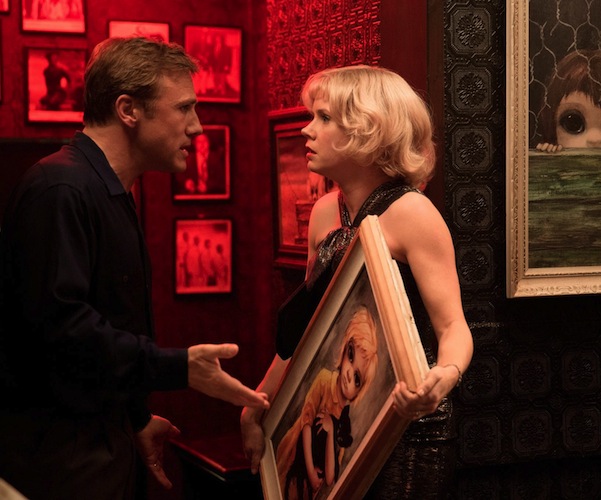Fuse Film Review: “Big Eyes” — Big Disappointment
Walter is pure evil. Margaret is pure good. And that is Big Eye‘s undoing.
Big Eyes, directed by Tim Burton. At screens around New England.

Amy Adams and Christoph Waltz battling over who gets the credit in a scene from “Big Eyes.”
By Paul Dervis
Big Eyes opened on Christmas Day with much fanfare. Mega-director Tim Burton’s latest offering stars Amy Adams at the center of a compelling true story that focuses on a tumultuous period of Americana (the swinging ’60s) that TV’s Mad Men has made quite topical. It promised to be an antidote to the usual attack of ‘feel-good’ holiday fare.
But it is not. For shame.
Big Eyes attempts to tell the story of artist Margaret Keane and her husband Walter, who stole the credit for her paintings in the early ’60s.
Adams has played leads in three of the best films of the past six years. She gave a complex portrayal of Sister James in John Patrick Shanley’s Doubt opposite Philip Seymour Hoffman. She then played the tough-as-nails love interest to Mark Wahlberg’s title character in Lowell’s own The Fighter. Earlier in her career she was cast as a resilient single mother in the chestnut Sunshine Cleaning. Adams has displayed her chops in the past and it is reasonable to expect she had ‘the stuff’ to drive this film. But it never happened. Her Margaret starts off as a naive housewife and never develops into anything more. Even as the film crescendos to its supposedly powerful climax, Adams’s character remains a cardboard cut-out.
Christoph Waltz, as Keane’s husband Walter, was absolutely appalling! He played each and every scene over the top. There is nothing subtle in this characterization, so the fact that Margaret couldn’t see through his veneer becomes implausible. Waltz, who has very recently won two Oscars, comes crashing down to earth in this one.
But it is Burton’s direction that leaves one scratching one’s head.
It appears to be a particularly apt fit, director and storyline. The creator of Ed Wood (not to mention Edward Scissorhands) should have had a field day with this grotesque story about big business and pop creativity. The plot is bizarre and that is Burton’s wheelhouse. Yet what we end up with is a straightforward narrative that never detours from an unimaginative, linear path. Each scene leads with irritating predictability into the next. Burton sleepwalks through Big Eyes and he never tries to wake the audience up.
Margaret Keane’s bathetic artwork was akin to the ‘Elvis on Velvet’ craze. She drew up those poor little waifs looking forlornly out to the viewer with those big, soulful eyes. Often the color combinations bear hugged the garish. The work had nothing really going for it, except for its inexplicable popularity. Her maudlin vision was a hit with Mid-America and became a pop phenomenon when it caught on with the nation’s middle class in the form of cheap posters and greeting cards. Art collectors never cared for the stuff but baby, mass appeal is where the money is.
But Margaret was denied her due. Walter was mistakenly given credit when he sold her first piece at the Hungry I Club in San Fransisco and convinced his wife that they could be richer if she allowed him the fame. Women artists don’t sell, Walter claimed. And she bought it.
Terrence Stamp gives the most layered performance as an art critic attempting to expose the paintings for what they are worth. But he isn’t in the film long enough to make much of a difference. Jason Schwartzman plays a San Fransisco gallery owner who disdains the work of both Keanes. He, too, gives a nice turn. Yet there is a problem with the screenplay here. He is shown Margaret’s work early on and rejects it. But when Walter takes ownership of the material, Schwartzman doesn’t seem to remember that it is the wife’s art, not Walter’s. He should have exposed the ruse early on; perhaps he suffered from amnesia.
Walter is pure evil. Margaret is pure good. And that is the film’s undoing. There are no shades of gray in Big Eyes, which is ironic for a movie about colorful (to-the-max) works of art. Given its director and quirky storyline (with its feminist resonances), the film should have been a nuanced tale that turned formulaic notions of creativity, gender, and the art world upside down. But what we get is paint-by-numbers moviemaking from a director who, in the past, has refused being conventional. How sad.
If you have seen the trailer for Big Eyes, then you have seen Big Eyes.
Paul Dervis has been teaching drama in Canada at Algonquin College as well as the theatre conservatory Ottawa School of Speech & Drama for the past 15 years. Previously he ran theatre companies in Boston, New York, and Montreal. He has directed over 150 stage productions, receiving two dozen awards for his work. Paul has also directed six films, the most recent being 2011’s The Righteous Tithe.
